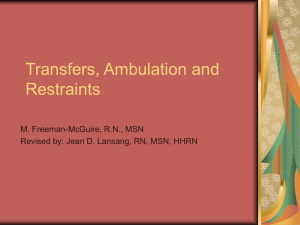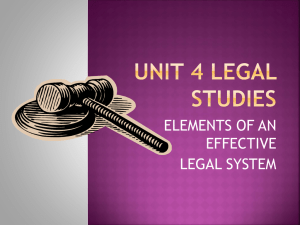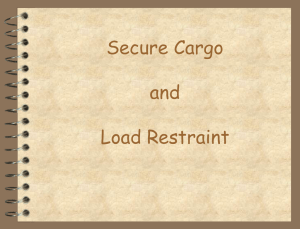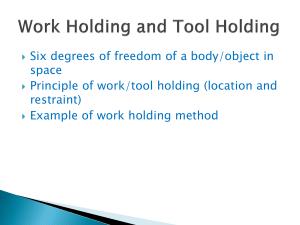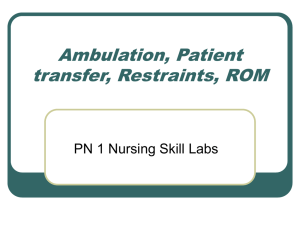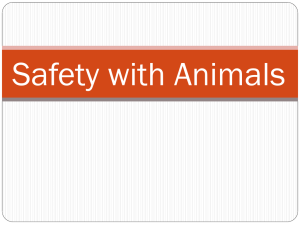Transfers, Ambulation and Restraints
advertisement
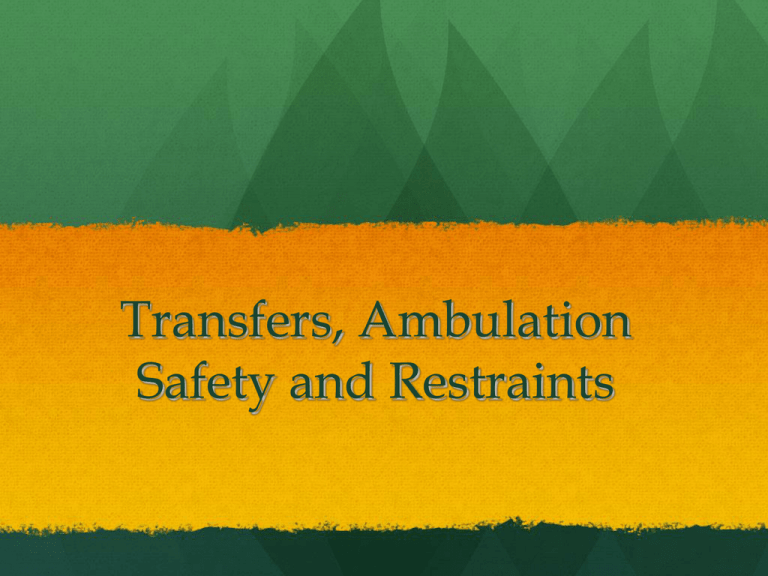
Transfers, Ambulation Safety and Restraints Lesson Objectives (Transfers), By the end of this lesson the student vocational nurse will be able to: Describe the procedure for transferring the client: moving up in bed, bed to chair, bed to stretcher, chair to bed, Explain at least three safety factors practiced while performing a transfer List common hazards encountered during a transfer Explain the importance of knowing the diagnoses and capabilities of the client Lesson Objectives (Ambulation), By the end of this lesson the student vocational nurse will be able to: List common hazards of ambulation and of using assistive devices Explain the importance of knowing the diagnoses and capabilities of the client Describe methods to support the client during ambulation Discuss various gaits used for walking with a cane, walker or crutches Create sample charting after ambulating a client, including the important data Lesson Objectives (Restraints), By the end of this lesson the student vocational nurse will be able to: Discuss rationale for using restraints Define the terms immobilize, legal rights, limb holder, chemical restraints Explain the patient’s Bill of Rights regarding consent of the client, family or guardian and written medical orders for use of restraints Discuss the procedure for applying various physical restraints Lesson Objectives (Safety), By the end of this lesson the student vocational nurse will be able to: Define vocabulary related to hospital/client environment. Discuss the effects of sensory deprivation for the client. Discuss purposes of space and how Identify personnel and committees that are involved in a nurse can respect the client's maintaining a safe, comfortable space. and the therapeutic environment in the hospital. Describe how to maintain the client's right to privacy. Discuss rationale for using restraints. Describe specific environmental factors that contribute to the List the common types of injury comfort and safety of the client. that may occur in the hospital setting Lesson Objectives (Safety), By the end of this lesson the student vocational nurse will be able to: Define the terms: a. Immobilized b. Legal rights c. Limb holder d. Chemical restraints Explain the Bill of Rights regarding consent of the client, family, or guardian and written medical orders for use of restraints. Discuss the procedure for applying various physical restraints. Transfers, Ambulation, Restraints Safety !!!! Transfers, Ambulation, Restraints (Safety Interventions): Assess for Orthostatic Hypotension Dangle Client with special needs: (eg.) blind Lock wheel chairs, stretchers and beds Check floors for safety (wet or clutter) Tub and shower surfaces Non-skid slippers Common Hazards Encountered: Unable to assist or follow directions Client fear Client fatigue Client weak Problem with assistive devices Inexperience of nurse Size of client Size of nurse Supporting The Client: Physically Emotionally Psychologically Tips: Moving from bed to chair: Chair on strong side Pivoting (client’s hand on arm of chair) Ambulating a Client: Support weak side Match client’s gate Basic Nursing Care: Comfort Safety Change Position Chair Cushions ROM Exercises Orientation of Client Therapeutic Touch Personal Items near Client Client Daily Habits ADL’S Documentation: Time Distance Use of Assistive Devices Client’s Feelings Weakness Poor Balance Dizziness Posture Other Problems Number of People to Assist Procedure for Transfers: Check the doctor’s orders Check diagnosis of the patient Dangle (usually necessary-after BR) Assist client to a sitting position, legs at side of bed, not touching the floor Allow client to dangle for several minutes May be necessary to return client to bed Orthostatic Hypotension (Signs and Symptoms): Dizziness Weakness Faint Fatigue Lightheadedness Orthostatic Blood Pressures: Lying Sitting Standing Orthostatic Hypotension: Systolic Blood Pressure drop < 25 mm Hg Diastolic Blood Pressure drop < 10 mm Hg Equipment (Transfers): Wheel Chair with Replacement Arm Geri Chair Transfer Belt Sliding Board Mechanical Lifts (Hoyer) Bed Scale Pull Sheet Moving Client Up In Bed: Position on back Ask client to bend knees and push with feet on the count of three Nurse assist client to the top of the bed (usually two person assist) Use good body mechanics Transfer (Two Person): Very overweight client Confused client Uncooperative client Transfer To Chair from Bed: Dangle Position (may be first step) Stand Pivoting (client’s arm on the arm of chair) Place chair on the client’s strong side Ambulation (common hazards with assistive devices): Broken Client not know how to use Pathways are not clear Equipment (ambulation) Same with few exceptions Gait Belts Crutch Walker Ambulation: Prevent Falls !!! Client Posture (head up, eyes open, looking forward) Non-skid slippers Walk at client’s side Match client’s gate Ambulation (Procedure): Walk on client’s weak side/match gate Stabilization (allow client to hold your elbow or hand) Minimal Support (hold client’s arm with your hand) Moderate Support (encircle client’s waist with your hand) Maximum Support (two persons, one on each side of client) Safety Define vocabulary related to hospital/client environment. Air Pollution – the introduction of checmicals, particulate matter or biological materials that cause harm or discomfort to human or other living Carbon Monoxide - (CO), also called carbonous oxide, is a colorless, odorless, and tasteless gas which is slightly lighter than air. It is highly toxic to humans and animals in higher quantities, although it is also produced in normal animal metabolism in low quantities, and is thought to have some normal biological functions. Carcinogen - s any substance, radionuclide or radiation that is an agent directly involved in causing cancer. Vocabulary related to hospital/client environment: Decibels - logarithmic unit that indicates the ratio of a physical quantity relative to a specified or implied reference level ( noise ratio). Relative humidity - is a term used to describe the amount of water vapor in a mixture of air and water vapor Sensory overload Parasites - Parasites are organisms that obtain food and shelter by living on or within another organism. Pathogens – microorganism that cause disease. Space and Privacy Purpose of Space 1. Importance of space 2. Nurse's role in protecting client space Maintaining the client's right to privacy 1. Screening 2. Requesting family/ friends to leave the room 3. Draping 4. Client consent to view procedures Environmental factors related to comfort & safety Temperature of room Relative humidity Physical hazards Carcinogens Pathogens Pollution Developmental factors Effects of Sensory Deprivation Cognitive Decreased learning Bizarre thinking Affective Boredom Restlessness Increased anxiety Perceptual Decreased attention span Confusion Personnel Maintaining Client Environment Medical and Nursing staff Housekeeping Engineering /Maintenance Common Hospital Injuries/Safety Common Hospital Injury Safety Falls Fire Safety Client-Incurred Accidents Earthquake Safety Procedure-Related Accidents Disaster Preparedness Equipment-Related Accidents Preventing Fall Identifying at-risk patients Assess for a history of falls Assess for additional risk factors Combining an assessment tool with a care plan Accurate assessment and use of appropriate fall intervention Preventing Falls: Determine the client's diagnoses and capabilities Floors Clean and Dry Floor Free from Clutter Anticipate Client Needs (toileting etc.) Know Client’ Diagnosis (eg.) CVA Blind Client’s, Alzheimer's Keep Belongings and Call Light in Reach, Bed in Low Position and Locked, Side Rails (!!!) Breaking Client’s Fall: Stand with your feet apart slightly behind the client Grasp the client firmly at waist/axilla Your near leg against the client’s leg Slowly lower the client to the floor Examine for injury Call for help Document as per agency policy Doctor notified Interventions for a Patient Who Experiences a Fall Immediately assess the patient’s condition Provide care and interventions appropriate for status/injuries Notify patient’s physician or primary caregiver of incident and your assessment of the patient Ensure prompt follow-through for any test orders Evaluate circumstances of the fall and the environment; institute preventive measures Document the fall and complete an event report Alternatives to Restraints Determine whether a behavior pattern exists Assess for pain and treat appropriately Rule out physical causes for agitation Involve family members Reduce stimulation, noise, and light Check environment for hazards and modify, if necessary Use therapeutic touch Investigate discontinuing bothersome treatment devices Restraints: Purpose Applied for safety Prevent injury Prevent dislodgement of tubes Psychiatric Setting Restraints Legal Consideration: Must be ordered by a physician in writing Emergency (can be applied by a nurse, orders within 24-48 hours) Documentation (all that was done to remedy situation before applying) Restraints: Must !!! Must help client or be needed for medical therapy Must be ordered by a physician Must not be used as a means of pushing or disciplining the client Must be applied snugly/not tightly Must be removed/Reposition Q2 Must notify doctor when no longer needed Must intervene to promote safety Must be documented Restraints Types: Safety Belts Wrist Extremity Immobilizer Vest (Posey) Hand Mittens Leather Chemical Restraints Basic Principals: Know agency policy Document use of restraints and patient monitoring Check client Q 15 minutes Remove and reposition Q 2 hours Assist with ROM Call light in reach Comfort measure (eg) water, food, rest room Restraints Basic Principals: Family Diversional Activities Psycho/Social (tough, isolation, confusion) Client’s daily habits (eg) news paper Neuro/Vascular Assessment Rapid Release of Restraints R-E-S-T-R-A-I-N-T Acronym R: Respond to the present, not the past E: Evaluate the potential for injury S: Speak with family members or caregivers T: Try alternative measures first R: Reassess the patient to determine success of restraint A: Alert the physician and family of need for restraint I: Individualize restraint use N: Note important information on chart T: Time limit the use of restraints Restraints Long Term Use (problems): Muscle weakness, atrophy Loss of bone mass, joint contractures Constipation/incontinence Pressure Ulcers Cognitive Impairment Decrease confidence in ambulation Withdrawn, detached Depression Loss of independence Conclusion Ask Yourself: Is my client safe from harm? Does my client need anything? Is the bed locked? Is the bed in the low position? Is the call light in reach? Does my client have anything to do? How is my client’s neuro/vascular assessment? Physical Restraints Restrict or control movement or behavior. They may be attached to a person's body or create physical barriers. wrist vest side rails wheelchair safety hand mittens Securing Restraint to Bed Frame Restraint Secured Behind Chair Using a Hand Mitt Child With Elbow Restraint in Place Chemical Restraints Chemical Restraints - are any medication used for the purpose of restraining patients involuntarily to prevent them from harming themselves or staff. Advantages of chemical restraints Control violent behavior and patient agitation May reduce need for physical restraints Allow examination and performance of radiographic imaging Disadvantages of Chemical Restraints • May result in complications, such as respiratory depression and loss of gag reflex • Occasional paradoxical reaction results in increased agitation • Limit mental status assessment and neurologic examination during sedation Environmental Restraints Change or modify a person's surroundings to restrict or control movement. For example, a locked door.
